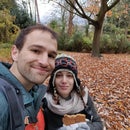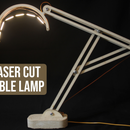Introduction: Tinfoil Studio Light
When your "studio" looks like mine, and you're using a smartphone to take pictures, you have to work really hard for them to look good. One of the things you quickly learn is that lighting is everything. You can try and edit images all night to make them look better, but if you started off with a bad image, it's pointless. Since many of us are writing instructables on our free time, it means that we're often doing it at night, and sunlight is long gone. That's an awful time of day to take pictures. To make it work, I decided to make my own studio lights. I tried to mimic the warm & well diffused sunlight. In this instructable I'll show you how I made it. I know, it looks a bit odd! but it absolutely works :)
Hope it helps you and that you enjoy reading! If you like my work feel free to check my instructables page for more projects :)
Step 1: Materials
You'll need:
1) Tinfoil
2) Supplies for making paper-mache (used paper, glue, water, paint)
3) a long rod. I used a metal rod I disassembled from an old printer, but a long wooden dowel would work too.
4) A light socket with a base (I used this one)
I also 3-D printed a small part, but you could make a similar part with leftover wood and a drill (you'll see what I mean in the coming steps).
Step 2: Cover the Wok With Tinfoil
To make a light that mimics natural light, we need to make sure it's very well diffused.
Wrinkle the tinfoil and cover the wok. Make sure to not leave empty spots. The wrinkles in the tinfoil means that light that you shine on it would be reflected in all directions - the light will be very well diffused.
Step 3: Making Paper Mache
I'm not an expert on paper mache, but you can read all about it on this site :)
Cut the paper to strips and prepare a mix of wallpaper glue and water. I also added some Elmer's glue (why not??) and acrylic paint. Add water and mix well.
Before dipping the paper strips in glue, dip them in warm water.
Step 4: Cover the Tinfoil With Pape Mache
Apply the paper mache to the tinfoil-covered wok all around.
While it dries (~24 hours in a warm & dry place), you can move on to the next steps.
Step 5: Wire the Light Socket & Connect Metal Rod
Drill a hole for the rod. The hole should point at the same direction as the light socket (see 4th image).
Wire the electric connections (make sure you know what you're doing!).
Thread the metal rod through the hole and glue everything in place. I used hot glue.
Step 6: Make an Adaptor
We need to connect the metal rod to the tinfoil dome. Since I have a 3D printer, that was the easiest solution for me, but you can easily make something out of wood. Just cut a round piece and drill a hole in it's middle for the rod to fit in. Use glue to attach the adaptor to the metal rod.
Attachments
Step 7: Attach to a Tripod
Use a standard nut (wiki page about tripods and their standards) to attach the light socket to a tripod.
If you don't have a tripod, you can skip this step. You can connect the light socket to other objects too (like a piece of wood or something similar).
Step 8: Attach the Aluminum Dome
Use glue to attach the aluminum dome to the adaptor you made. Make sure that the light-bulb is facing its center - this means that you might have to attach the adaptor slightly off-center like I did.
That's it! your studio lights are done!
Step 9: You're Ready to Take Pictures!
To use this light source properly, position it so that the light bulb is facing away from the objects you're capturing - you only want reflected (diffused) light to shine on the stuff you're taking pictures of.
You can use this diffused light source to mimic sunlight during the night. Also, if you position the light well enough, you can use it during the day to cancel out shadows created by natural sunlight (or other light sources).
Hope this instructable helps you get your studio closer to where you want it to be! It certainly helped mine :)





